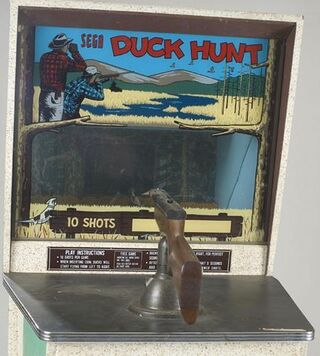Difference between revisions of "Duck Hunt"
From Sega Retro
(→Legacy) |
|||
| Line 19: | Line 19: | ||
==Legacy== | ==Legacy== | ||
| − | After ''Duck Hunt'', Sega produced several more electro-mechanical arcade games based on the same technology, using rear image projection in a manner similar to | + | After ''Duck Hunt'', Sega produced several more electro-mechanical arcade games based on the same technology, using rear image projection in a manner similar to a zoetrope to produce moving animations on a screen. In 1969, Sega released the electro-mechanical games ''[[Grand Prix]]'', a first-person driving/racing game projecting a forward-scrolling road on a screen, and ''[[Missile]]'', a first-person vehicle combat simulation that had a moving film strip project targets on screen and a dual-control scheme where two directional buttons move the player tank and a two-way joystick with a fire button shoots and steers missiles onto oncoming planes, which explode when hit. In 1970, the game was released in North America as ''S.A.M.I.'' That same year, Sega released ''[[Jet Rocket]]'', a first-person combat flight sim with cockpit controls that could move the player aircraft around a landscape displayed on screen and shoot missiles onto targets that explode when hit. In 1972, Sega released ''[[Killer Shark]]'', a first-person light gun game known for appearing in the 1975 film Jaws. |
The game also may have influenced [[Nintendo]]'s light-gun shooters. In 1974, Nintendo's arcade light gun shooter ''Wild Gunman'' used similar technology, but improved it even further by using full-motion video projection to display live-action cowboy opponents on screen. In 1984, Nintendo released their own video game called ''Duck Hunt'', which played more or less similarly to Sega's 1969 electro-mechanical arcade game of the same name. | The game also may have influenced [[Nintendo]]'s light-gun shooters. In 1974, Nintendo's arcade light gun shooter ''Wild Gunman'' used similar technology, but improved it even further by using full-motion video projection to display live-action cowboy opponents on screen. In 1984, Nintendo released their own video game called ''Duck Hunt'', which played more or less similarly to Sega's 1969 electro-mechanical arcade game of the same name. | ||
Revision as of 08:47, 31 December 2015
Duck Hunt is a January 1969 electro-mechanical arcade game produced by Sega. The 25-cent game features 10 animated ducks flying on a screen from left to right which disappear when shot with the attached shotgun controller.
The player receives ten shots, and the shot ducks are framed in a duck hunting score. Shooting the shot gun and hitting a duck produces a sound effect. The game dispenses a perforated computer card-style ticket showing shooting accuracy and score when game is finished which could be used for prizes or as a permanent record of the player's score. Additionally, the game could be set to give a free game for a perfect score.
Overview
It resembles a first-person light-gun shooter video game, but is in fact an electro-mechanical arcade game that uses rear image projection in a manner similar to a zoetrope to produce moving animations on a screen.
This was the first electronic arcade game with animated targets displayed on a screen, in contrast to earlier electro-mechanical arcade games that displayed actual physical static targets. This gave Duck Hunt the appearance of a video game, several years before the first true video games arrived in the arcades (Computer Space and Pong). Duck Hunt thus anticipated the kind of light-gun shooter video games that would later appear in the 1970s, and was the first electronic arcade game to display a first-person perspective on a screen. Duck Hunt was later updated by Midway and re-released in January 1973.
Legacy
After Duck Hunt, Sega produced several more electro-mechanical arcade games based on the same technology, using rear image projection in a manner similar to a zoetrope to produce moving animations on a screen. In 1969, Sega released the electro-mechanical games Grand Prix, a first-person driving/racing game projecting a forward-scrolling road on a screen, and Missile, a first-person vehicle combat simulation that had a moving film strip project targets on screen and a dual-control scheme where two directional buttons move the player tank and a two-way joystick with a fire button shoots and steers missiles onto oncoming planes, which explode when hit. In 1970, the game was released in North America as S.A.M.I. That same year, Sega released Jet Rocket, a first-person combat flight sim with cockpit controls that could move the player aircraft around a landscape displayed on screen and shoot missiles onto targets that explode when hit. In 1972, Sega released Killer Shark, a first-person light gun game known for appearing in the 1975 film Jaws.
The game also may have influenced Nintendo's light-gun shooters. In 1974, Nintendo's arcade light gun shooter Wild Gunman used similar technology, but improved it even further by using full-motion video projection to display live-action cowboy opponents on screen. In 1984, Nintendo released their own video game called Duck Hunt, which played more or less similarly to Sega's 1969 electro-mechanical arcade game of the same name.
Specifications
- Height: 69"
- Width: 28"
- Depth: 38"




